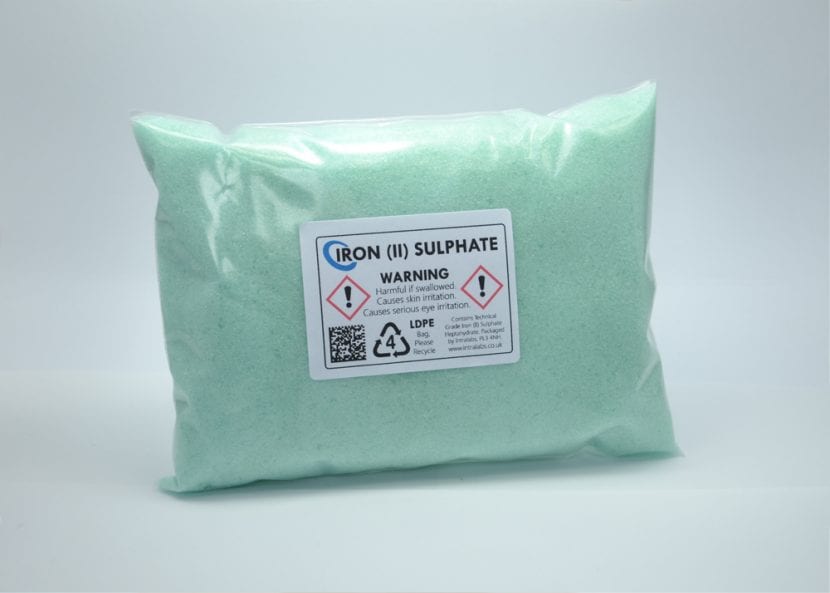

Image – INTRALABS
Unfortunately, not all plants can grow equally well in all types of soil. For this reason, sometimes its leaves begin to become chlorotic due to the lack of some mineral (usually iron, but it can also be magnesium). Once that happens to them, we will see that nerves become more visible if possible, then chlorophyll, that is, the green substance of the foliar parts of plants, is concentrated only in them.
If the mineral it needs is not supplied quickly, that leaf will end up completely withering until it falls. To avoid this, one of the things we can do is put some iron sulfate on the ground. In this way, the pH will be lowered and the roots will be able to absorb everything they need to grow.
What is iron sulfate?


Image – TECNICROP
Iron sulfate is a chemical compound of inorganic origin that is formed from metallic iron and sulfuric acid. Depending on the oxidation state of said iron, we distinguish:
Iron (II) sulfate
Or ferrous sulfide, it is a compound obtained from the reaction between iron and sulfur. It is blue-green in color, and is often used a lot in gardening to lower the pH of the soil.but also for educational purposes because it is a ferromagnetic substance (it can be attracted by magnets) and endothermic (it absorbs energy).
Iron (III) sulfate
It is a compound obtained from the reaction of iron, sulfur and oxygen. Appearance like solid salt, it is used as a coloring and in medicine as an astringent.
In gardening it is not used.
Where to buy?
In nurseries and garden stores we can often find sachets with a kind of apple green powder or brown / white granules. The former are the most suitable for dissolving in water as they are much finer particles; in addition, they have a faster efficiency than the second ones, which have to break down as they are watered.
When and how is it applied?


Image – Flickr / Agronomic Planet Archives
In water
Iron sulfate is applied when we grow acidophilic plants (maples, camellias, azaleas, magnolias, among others) in lands with a pH that is higher than 6, and when we use irrigation water that has a lot of lime to prevent the appearance of chlorosis. Thus, throughout the year we have to take a few 3 grams of sulfate for every liter of waterand water with it once a month.
In the garden
We will add between 35 and 50 grams per square meter of soilif what we want is to lower the pH of a limestone soil. Although it is important to bear in mind that for it to be really effective we must water with water whose pH is either neutral or acid, because if it is alkaline, that pH of the earth will remain high, that is, alkaline.
In pots
For potted plants it is more advisable to use substrates for acidic plants (on sale here!) and water with somewhat acidic water. Therefore, in this case it is not necessary to use iron sulfate, but the water is very hard, with a pH greater than 6, it has to be acidified by dissolving the liquid of half a lemon in 1l / water.
You have to check the pH, for example with a digital meter (on sale here!), since if it goes below 4 it would not be good either.
Can it be applied by foliar way?


Foliar application products have a much faster effectiveness, since they act directly on one of the most important parts of the plants: the leaves. They, through their pores, absorb them, without having to ‘wait’ for it to reach them through the vessels of trunks and / or branches.
But is it a good idea to apply iron sulfate this way? To answer this question, it is necessary to differentiate chelates from complexes: the former is recommended to be used via the root canal, while the complexes will be those that we apply by foliar route.
Iron chelate
Chelated iron, which is another name it receives, used primarily to correct iron deficiencies; that is, when there are already symptoms of a lack of this mineral or, what amounts to the same, when there is already chlorosis.
The dose is 30 to 50 grams if they are developing plants, and 50 to 100 grams if they are large and adult plants.
What function does iron have for plants?


Plants need a wide variety of nutrients to grow and be well, and iron is one of them. Although it is considered a micronutrient, since they need it to a lesser degree than nitrogen or phosphorus for example, without it they would have many problems, since fulfills very important functions:
- Helps produce energy
- It is essential for the formation of chlorophyll (the green pigment in leaves and stems)
- Reduces nitrates and sulfates
- It is a constituent of some pigments and enzymes
Its lack will cause the yellowing of the leaves, a poorer development in general, and consequently, a weaker plant. For this reason, it is necessary to know the pH of the substrate or of the soil and to know if it is suitable for the type of plant we want to grow, because if it is a very high pH the roots will not be able to directly access the iron, and this to the acidophilic is something they will not like.
I hope these tips help you to have a dream garden .
